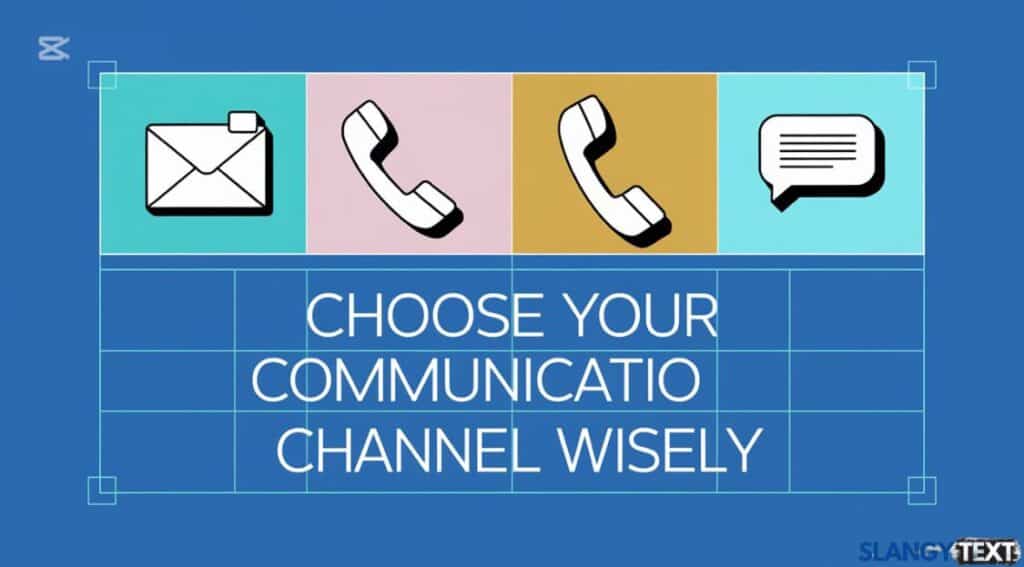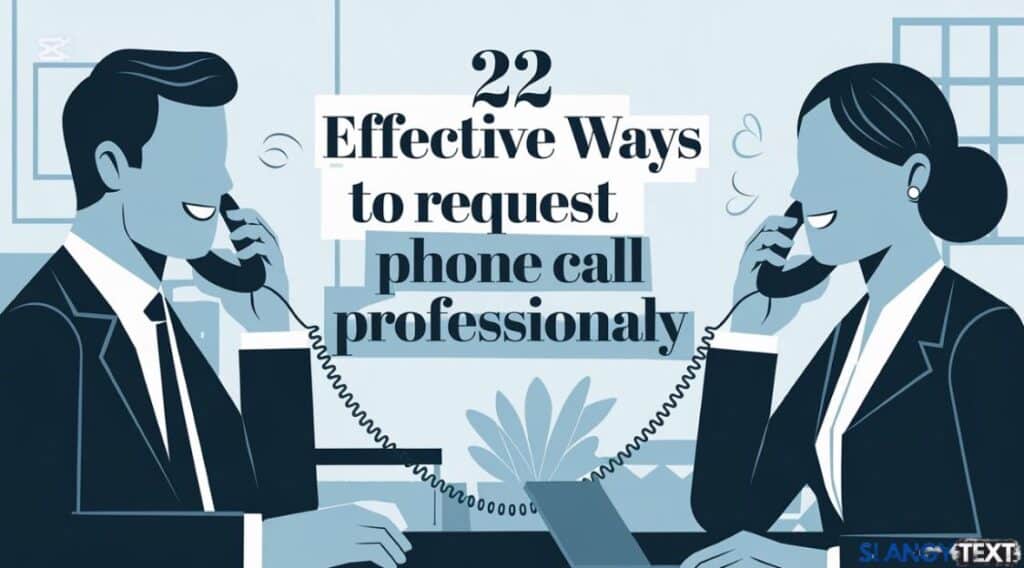Introduction to Professional Phone Communication
In the digital age of emails, instant messages, and video conferences, the phone call remains a powerful tool of professional communication.Let’s dive deep into 22 Effective Ways to Request a Phone Call Professionally.
Despite the proliferation of digital communication channels, telephonic exchanges continue to offer unparalleled immediacy, nuance, and personal connection that cannot be replicated through text-based interactions.
Scenario Table: Communication Effectiveness
| Communication Method | Best Used For | Professional Scenario |
|---|---|---|
| Formal documentation | Sending contract details | |
| Phone Call | Urgent discussions | Resolving complex project issues |
| Video Conference | Team collaboration | Global strategy meetings |
| Instant Message | Quick updates | Confirming meeting times |
| Text Message | Immediate notifications | Project status alerts |
Technique 1: The Direct Professional Approach
Professional Context: In today’s fast-paced business environment, directness can be a virtue when communicating urgent or critical matters. This approach eliminates ambiguity and demonstrates professional confidence.
Scenario Example: Sarah, a marketing manager at TechInnovate, needs to discuss a critical campaign adjustment with her client, John from GlobalBrands. Her direct request reads: “Would you be available for a 20-minute phone discussion about our upcoming digital marketing strategy? I have some urgent recommendations that could significantly impact our campaign performance.”
Technique 2: The Context-Driven Request
Professional Context: Successful communication hinges on providing clear context that immediately captures the recipient’s attention and demonstrates the value of the proposed conversation.
Scenario Example: David, a software development lead, is working on a complex project integration. He emails his external consultant: “Can we talk on the phone regarding the quarterly review of our software architecture? I’ve identified three critical optimization points that require immediate technical discussion.”
Technique 3: The Time-Sensitive Invitation
Professional Context: When critical business decisions cannot wait, professionals must craft requests that convey both urgency and respect for the recipient’s time.
Scenario Example: Jennifer, a procurement specialist, is dealing with a potential supply chain disruption. Her urgent request states: “I would appreciate a quick phone chat to address the time-sensitive matters concerning our vendor contract. We need to make an immediate decision to prevent potential production delays.”
Technique 4: The Collaborative Approach
Professional Context: Modern business success relies on collaborative efforts, and the way you request a discussion can set the tone for potential partnerships and joint initiatives.
Scenario Example: Robert from a renewable energy consulting firm wants to align with a potential partner. He writes: “Would you mind if we coordinate a convenient time for our phone discussion about collaborative sustainability initiatives? I believe we can create a more impactful strategy together.”
Technique 5: The Empathetic Request
Professional Context: Empathy in professional communication demonstrates emotional intelligence and can significantly improve the receptiveness of your communication strategy.
Scenario Example: Emily, a human resources manager, approaches a potential job candidate: “I understand you’re likely busy preparing for interviews, but could we arrange a brief call session to discuss the role? I’ll ensure our conversation is focused and respectful of your time.”
Technique 6: The Strategic Follow-up
Professional Context: Persistence is a key attribute in professional communication, but it must be balanced with strategic timing and respectful approach. Effective follow-ups demonstrate commitment without becoming intrusive.
Scenario Example: James, a sales representative, follows up on a proposal: “I’m reaching out again about our potential phone meeting to discuss the customized solution for your business. Would you be available for a 15-minute conversation this week to address any questions?”
Technique 7: The Value-Driven Approach
Professional Context: Every professional communication should inherently answer the recipient’s unspoken question: “What’s in it for me?” Articulating clear value proposition transforms a simple request into an compelling invitation.
Scenario Example: Sarah from a management consulting firm reaches out: “I believe a quick phone conversation could help us identify potential efficiency improvements in your current operational structure. Our initial analysis suggests significant cost-saving opportunities.”
Technique 8: Virtual Meeting Alternatives

Professional Context: Flexibility in communication reflects adaptability, a crucial skill in today’s global and increasingly remote work environment. Offering multiple communication channels demonstrates professional versatility.
Scenario Example: Mark, an international project coordinator, offers flexibility: “Given our different time zones, would you prefer a phone call or a video conference to discuss the project details? I’m happy to accommodate your communication preference.”
Technique 9: The Concise Professional Request
Professional Context: In an era of information overload, brevity is a sophisticated communication skill. A succinct request shows respect for the recipient’s time and demonstrates professional efficiency.
Scenario Example: Amanda, a product manager, needs a quick alignment: “Can we talk on the phone about our product roadmap? I have critical updates that will impact our next quarter’s development strategy.”
- You Might Also Like : 20 Professional Ways To Say “It Was A Pleasure Meeting You”
Technique 10: The Expert Consultation Request
Professional Context: Seeking expert insights demonstrates humility, intellectual curiosity, and a commitment to continuous learning. Professionals who actively seek knowledge are viewed as growth-oriented and innovative.
Scenario Example: Jessica reaches out to an industry veteran: “As an expert in renewable energy technologies, I would greatly value a brief phone discussion to gain your insights on our latest solar panel innovation.”
Technique 11: The Networking Connection Request
Professional Context: Strategic networking is the cornerstone of professional growth, transforming chance encounters into meaningful professional relationships. Each interaction is an opportunity for potential collaboration.
Scenario Example: Kevin, after attending an industry conference, follows up: “Our conversation about artificial intelligence at the recent tech summit was fascinating. Would you be interested in a brief phone discussion to explore potential collaborative opportunities?”
Technique 12: The Research and Insight Request
Professional Context: Knowledge sharing is a powerful form of professional currency. Demonstrating genuine interest in someone’s work can open doors to unexpected opportunities and collaborative insights.
Scenario Example: Rachel contacts an academic researcher: “Your recent publication on machine learning algorithms provides groundbreaking insights. Would you be open to a short phone conversation to discuss the practical applications of your research?”
Technique 13: The Problem-Solving Invitation
Professional Context: Proactive problem-solving distinguishes exceptional professionals. By inviting collaborative resolution, you position yourself as a solution-oriented team player rather than merely highlighting challenges.
Scenario Example: Thomas identifies a potential project challenge: “I’ve discovered a potential bottleneck in our current development process. Could we schedule a phone call to brainstorm innovative solutions and mitigate potential risks?”
Technique 14: The Progress Review Request
Professional Context: Regular progress reviews are essential for maintaining project momentum and alignment. They provide opportunities for transparent communication and strategic recalibration.
Scenario Example: Elena needs a comprehensive project update: “Let’s schedule a brief phone meeting to review our international expansion project’s current progress, discuss challenges, and align on our strategic next steps.”
Technique 15: The Mentor Guidance Request
Professional Context: Mentorship represents a sacred professional relationship built on mutual respect, learning, and shared wisdom. A thoughtful request can transform a potential interaction into a transformative career moment.
Scenario Example: Daniel approaches a respected industry leader: “I’ve been following your remarkable career in sustainable technology. Would you be willing to spare 20 minutes for a mentorship phone discussion about navigating professional challenges?”
Technique 16: The International Collaboration Request

Professional Context: Global business requires cultural sensitivity and communication flexibility. Understanding and respecting international time differences demonstrates professional sophistication and global mindset.
Scenario Example: Maria coordinates with a global team member: “Considering our significant time difference between New York and Tokyo, would a phone call at 8 AM Eastern Time work for discussing our collaborative research project?”
Technique 17: The Urgent Problem Resolution
Professional Context: Crisis management is a critical professional skill that separates reactive individuals from proactive leaders. Immediate, clear communication can prevent escalation and demonstrate competence.
Scenario Example: Alex encounters a critical system failure: “We’re experiencing an urgent cybersecurity vulnerability that requires immediate attention. Could we have a phone call within the next two hours to develop an immediate mitigation strategy?”
- Also Like To Know This : What Is The Collective Nouns For Mountains?
Technique 18: The Client Relationship Management
Professional Context: Long-term client relationships are built on consistent communication, trust, and demonstrated value. Each interaction is an opportunity to reinforce your commitment and professional excellence.
Scenario Example: Sophia maintains a key client relationship: “I value our ongoing partnership with MegaCorp and would like to schedule a brief phone discussion to ensure we’re consistently meeting and exceeding your organizational expectations.”
Technique 19: The Sales Opportunity Exploration
Professional Context: Modern sales transcend traditional pitching, focusing instead on understanding client needs and presenting tailored solutions. A well-crafted communication approach can transform a cold contact into a potential partnership.
Scenario Example: Ryan approaches a potential client: “Our AI-driven solution could potentially reduce your operational costs by 35%. Would you be open to a 15-minute phone discussion to explore how we can transform your business efficiency?”
Technique 20: The Performance Feedback Request
Professional Context: Continuous improvement is the hallmark of exceptional professionals. Actively seeking feedback demonstrates vulnerability, courage, and a genuine commitment to personal and professional growth.
Scenario Example: Lisa seeks professional growth: “As part of my commitment to continuous improvement, could we schedule a phone call to discuss my recent project performance, identify strengths, and develop strategies for professional development?”
Technique 21: The Crisis Management Communication
Professional Context: Effective crisis communication requires a delicate balance of transparency, confidentiality, and strategic thinking. The right approach can transform a potential disaster into a manageable challenge.
Scenario Example: Jason handles a sensitive corporate situation: “Given the complexity of our current merger negotiations, a direct phone conversation would be most appropriate to address the nuanced challenges we’re collectively facing.”
Technique 22: The Professional Courtesy Check-In
Professional Context: Genuine professional relationships are built on more than transactional interactions. Periodic check-ins demonstrate care, maintain connections, and keep communication channels open.
Scenario Example: Olivia demonstrates professional care: “Following our last strategic planning session, I wanted to check in and see if a brief phone call would help us clarify and accelerate our implementation roadmap.”
Conclusion: Elevating Professional Communication

Mastering the art of requesting a phone call involves understanding context, demonstrating respect, and communicating value. By implementing these 22 strategies, professionals can transform simple communication requests into meaningful business dialogues.
- Must Explore : Understanding Boy’s, Boys’, And Boys: A Simple Guide

Kayla Rogers is a writer at Slangy Text who loves exploring modern acronyms & slangs and how they shapes our conversations. She enjoys sharing fun and interesting articles that connect with readers. When she’s not writing, Kayla likes to keep up with the latest trends or relax with a good book.







